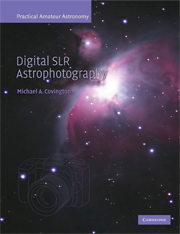4 - Four simple projects
Published online by Cambridge University Press: 21 August 2009
Summary
After all this, you're probably itching to take a picture with your DSLR. This chapter outlines four simple ways to take an astronomical photograph. Each of them will result in an image that requires only the simplest subsequent processing by computer.
All of the projects in this chapter can be carried out with your camera set to output JPEG images (not raw), as in daytime photography. The images can be viewed and further processed with any picture processing program.
Telephoto Moon
Even though the Moon is not ultimately the most rewarding object to photograph with a DSLR, it's a good first target.
Put your camera on a sturdy tripod and attach a telephoto lens with a focal length of at least 200 and preferably 300 mm. Take aim at the Moon. Initial exposure settings are ISO 400, f/5.6, 1/125 second (crescent), 1/500 second (quarter moon), 1/1000 (gibbous), or 1/2000 (full); or simply take a spot meter reading of the illuminated face of the Moon. An averaging meter will overexpose the picture because of the dark background.
If the camera has mirror lock (Canon) or exposure delay (Nikon), turn that feature on. Let the camera autofocus and take a picture using the self-timer or cable release. View the picture at maximum magnification on the LCD display and evaluate its sharpness. Switch to manual focus and try again, varying the focus slightly until you find the best setting. Also adjust the exposure for best results.
- Type
- Chapter
- Information
- Digital SLR Astrophotography , pp. 38 - 46Publisher: Cambridge University PressPrint publication year: 2007



